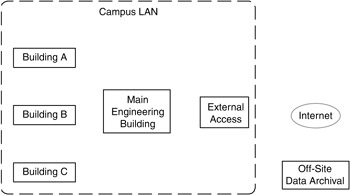2.11 Exercises
2.11 Exercises
-
Why is requirements analysis important to network architecture and design? Give three reasons.
-
Categorize each of the following requirements as core (fundamental), feature, or informational.
-
Network must support Fast Ethernet and GigE interfaces for all devices on the network.
-
Network backbone should be upgradable in capacity to 10 Gb/s within 2 years of deployment.
-
Finance department requires firewall protection to their server.
-
Existing network consists of 10BaseT Ethernet and FDDI segments.
-
Network personnel would like to be able to bill users for network service.
-
Network core must not generate or terminate any user traffic.
-
Network must support digital video traffic from remote video cameras and may additionally support sound from these cameras.
-
-
Categorize each of the following requirements as user, application, device, or network.
-
Database servers must run brand XYZ software.
-
Teleconferencing requires at least 350 Kb/s capacity.
-
Users must be able to submit print jobs of up to 25 MB in size.
-
Each access network should be able to service 200 corporate users.
-
-
Give an example of a requirement as it flows from user to application to device to network. Show how it becomes more technical at each component.
-
Which of the following customer requirements could be categorized as mission-critical? As rate-critical? As real-time? As none of these? Give reasons for each choice.
-
Processing telemetry data from a space shuttle launch and providing that data to mission control during launch. (Customer: NASA.)
-
Processing requests from automated teller machines throughout a city. (Customer: bank.)
-
Processing requests for Web pages from your servers. (Customer: Internet service provider).
-
-
Give an example of a mission-critical application for each of these three environments: government, military, commercial. Why would each application be considered mission-critical?
-
Section 2.5.1 describes several types of delay (real-time, interactive-burst, interactive-bulk, and asynchronous). Give examples of applications or traffic types that have each type of delay.
-
Delay performance is increasingly important in support of user and application requirements. Describe why delay is important for the following applications:
-
Voice over IP (VoIP)
-
Nonbuffered (real-time) video or audio playback
-
Teleconferencing
-
-
Based on the following application locations, develop an applications map using the template provided in Figure 2.17.

Figure 2.17: Template for Exercise 9.-
There is a distributed computing application between all compute servers.
-
There is a data storage/access application between all compute servers and the storage servers in Main Engineering.
-
There is a data migration application between Main Engineering, External Access Building, and Off-Site Data Archival.
-
-
Which devices below can be considered generic computing devices? Servers? Specialized devices?
-
An ATM machine
-
Laptops running Linux OS
-
IBM computing cluster of 128 PCs
-
Sun Enterprise 450 database server
-
Desktop PC running Windows 2000
-
-
Add the following devices to the Applications Map developed in Problem 4.
-
Compute servers are located in Buildings A, B, and C (1 server each), and 5 compute servers are located in Main Engineering.
-
Storage servers are located in Main Engineering (2 servers), External Access Building (1 server), and at the Off-Site Data Archival location (1 server).
-
-
List the top 10 applications that you expect to use in your (or your customer's) network or that you currently use in the existing network. List the actual or estimated performance characteristics for each application and try to place them into groups. You can also try to map them to the application groups listed in Section 2.5.2.
EAN: 2147483647
Pages: 161